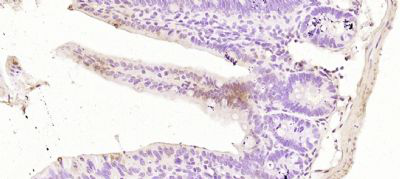产品货号 : mlR21598
英文名称 : SNAIL
中文名称 : Snail蛋白抗体
别 名 : dJ710H13.1; Protein sna; Protein snail homolog; SLUGH2; SNA; Sna protein; SNAH; SNAI1; SNAI 1; Snail homolog 1 (Drosophila); Zinc finger protein SNAI1; SNAI1_HUMAN; Protein snail homolog 1; dJ710H13.1; SNAIL; SNAIL1; Protein sna.
研究领域 : 肿瘤 心血管 细胞生物 信号转导 转录调节因子 锌指蛋白 表观遗传学
抗体来源 : Rabbit
克隆类型 : Polyclonal
交叉反应 : Human, Mouse, Rat,
产品应用 : ELISA=1:500-1000 IHC-P=1:400-800 IHC-F=1:400-800 ICC=1:100-500 IF=1:100-500 (石蜡切片需做抗原修复)
not yet tested in other applications.
optimal dilutions/concentrations should be determined by the end user.
分 子 量 : 29kDa
细胞定位 : 细胞核 细胞浆
性 状 : Lyophilized or Liquid
浓 度 : 1mg/ml
免 疫 原 : KLH conjugated synthetic peptide derived from human SNAIL:1-100/264
亚 型 : IgG
纯化方法 : affinity purified by Protein A
储 存 液 : 0.01M TBS(pH7.4) with 1% BSA, 0.03% Proclin300 and 50% Glycerol.
保存条件 : Store at -20 °C for one year. Avoid repeated freeze/thaw cycles. The lyophilized antibody is stable at room temperature for at least one month and for greater than a year when kept at -20°C. When reconstituted in sterile pH 7.4 0.01M PBS or diluent of antibody the antibody is stable for at least two weeks at 2-4 °C.
PubMed : PubMed
产品介绍 : The zinc finger transcription factor 'SNAIL' was first identified in Drosophila and, along with 'twist', a basic helix-loop-helix transcription factor, is indispensable for mesoderm formation. SNAIL is a repressor of mouse E-cadherin transcription, with expression of SNAIL inversely correlated with expression of E-cadherin. Abnormal expression of SNAIL could underlie the tumorigenic conversion of epithelia associated with loss of E-cadherin expression through screening mouse and human cell lines and by in situ hybridization of primary human tumors undergoing malignant progression.
Function:
Involved in the epithelial to mesenchymal transition (EMT) and formation and maintenance of embryonic mesoderm. Binds to 3 E-boxes of the E-cadherin gene promoter and represses its transcription.
Subunit:
Interacts with FBXL14 and GSK3B. Interacts with BTRC; interaction occurs when it is phosphorylated on the destruction motif. Interacts (via SNAG domain) with WTIP (via LIM domains). Interacts (via SNAG domain) with LIMD1 (via LIM domains), and AJUBA (via LIM domains). Interacts with LOXL2 and LOXL3.
Subcellular Location:
Nucleus. Cytoplasm. Note=Once phosphorylated (probably on Ser-107, Ser-111, Ser-115 and Ser-119) it is exported from the nucleus to the cytoplasm where subsequent phosphorylation of the destruction motif and ubiquitination involving BTRC occurs.
Tissue Specificity:
Expressed in a variety of tissues with the highest expression in kidney. Expressed in mesenchymal and epithelial cell lines.
Post-translational modifications:
Phosphorylated by GSK3B. Once phosphorylated, it becomes a target for BTRC ubiquitination.
Ubiquitinated on Lys-98, Lys-137 and Lys-146 by FBXL14 and BTRC leading to degradation. BTRC-triggered ubiquitination requires previous GSK3B-mediated SNAI1 phosphorylation.
O-GlcNAcylation at Ser-112 is enhanced in hyperglycaemic conditions, it opposes phosphorylation by GSK3B, and stabilizes the protein.
Similarity:
Belongs to the snail C2H2-type zinc-finger protein family.
Contains 4 C2H2-type zinc fingers.
SWISS:
O95863
Gene ID:
6615
Important Note:
This product as supplied is intended for research use only, not for use in human, therapeutic or diagnostic applications.
Snail蛋白主要用于消化系统肿瘤方面的研究
产品图片












